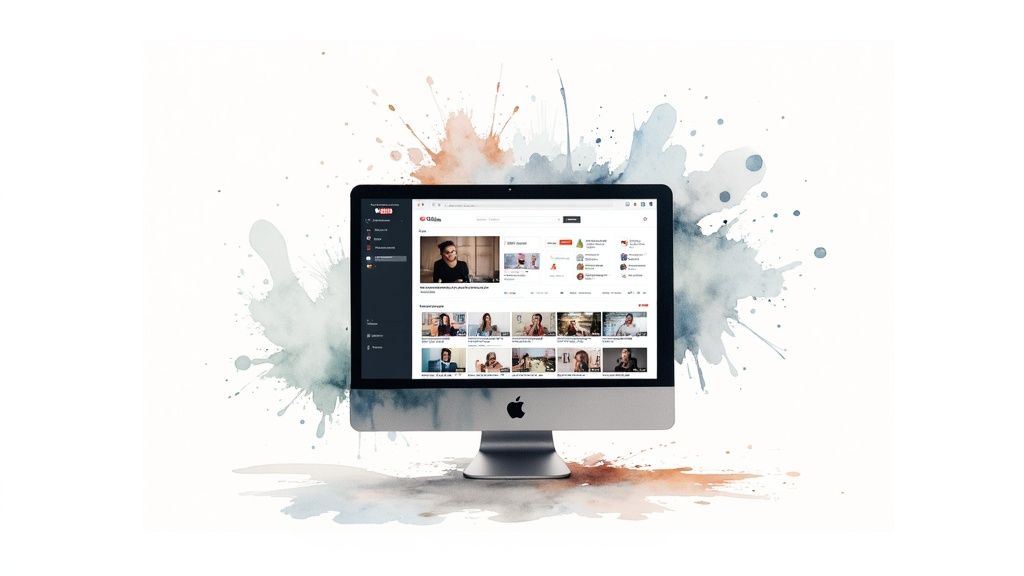Mastering Video Monetization Fundamentals

Successfully monetizing your videos requires a solid grasp of the different ways you can generate revenue. These revenue streams fall into two main categories: direct and indirect.
Direct revenue is straightforward: it's money earned directly from your viewers. Think advertising revenue (pre-roll, mid-roll, and display ads) and memberships or subscriptions where viewers pay for exclusive content.
Indirect revenue, on the other hand, is earned through other avenues. These include sponsorships, where brands pay to be featured in your videos, and affiliate partnerships, where you earn a commission for promoting other companies’ products or services. Finding the right balance between direct and indirect revenue is key for sustainable growth.
Understanding how platform algorithms work is also vital. Algorithms prioritize content that keeps viewers hooked. This means audience demographics and engagement metrics (like watch time, comments, and shares) often carry more weight than your total subscriber count.
A smaller, highly engaged audience can be more valuable than a larger, passive one, especially for attracting sponsors or promoting niche products. This underscores the importance of building a real community around your content.
Platform Choice and Engagement
Effective video monetization hinges on choosing the right platform. A platform that fosters engagement is essential. YouTube continues to be a dominant force in video marketing.
As of 2023, approximately 90% of video marketers use YouTube. The platform generated an impressive $50 billion in ad and subscription revenue in just the past four quarters.
This success is partially due to YouTube’s massive user base and its support for long-form content, which boasts an average Revenue Per Mille (RPM) of around $3. Want to explore video marketing trends? Check out the latest statistics here.
Realistic Earning Expectations
While earning big is possible, it's crucial to have realistic expectations. Earning potential varies greatly based on factors like your niche, audience size, engagement levels, and chosen monetization methods.
Gaming channels, for example, often see higher ad revenue thanks to longer watch times. Educational channels might perform better with sponsorships or affiliate marketing. Choose monetization strategies that align with your content and audience.
Meeting Platform Requirements
Finally, each platform has its own rules for monetization. YouTube, for instance, requires a minimum of 1,000 subscribers and 4,000 valid watch hours in the past 12 months.
Understanding these requirements and adapting your strategy is key to unlocking different monetization features. However, don’t let meeting these requirements compromise your creative vision. Authentic content that resonates with your audience is the ultimate key to success.
Platform-Specific Revenue Tactics That Actually Work

Monetizing videos effectively requires a deep understanding of each platform's audience and how it operates. Simply enabling basic features isn't enough. This section explores proven platform-specific tactics to drive revenue on major video platforms, revealing opportunities often overlooked for substantial income growth.
YouTube: Beyond The Basics
YouTube, with its massive user base, offers diverse monetization options beyond standard advertising. A key strategy is creating a thriving membership program. By offering exclusive content, badges, and community features, you can cultivate a loyal fanbase willing to pay for premium access.
Another powerful tactic is leveraging YouTube Shopping. Tag products directly in your videos, making it easy for viewers to purchase recommended items. This is especially lucrative for review channels, tutorials, or any content showcasing products.
TikTok: Capitalizing On Trends
TikTok's fast-paced environment demands a different approach. Short-form, engaging content is king. Capitalize on trends, participate in challenges, and create shareable content that encourages viral spread.
Monetization on TikTok often revolves around brand partnerships. Building a strong presence and cultivating a niche audience makes you an attractive partner for brands targeting specific demographics. TikTok's Creator Marketplace streamlines this process, connecting creators with brands.
Instagram: Leveraging Visual Storytelling
Instagram thrives on visual storytelling. High-quality, aesthetically pleasing content is essential. Instagram Reels are a prime opportunity to capture attention and drive engagement.
Similar to TikTok, brand collaborations are key for monetization. Instagram Shopping also allows creators to sell products directly, creating a seamless shopping experience for followers.
Emerging Platforms: Early Adoption Advantage
While established platforms offer substantial opportunities, exploring emerging platforms can provide a significant head start. New platforms often present unique monetization models and less competition.
Thoroughly research potential platforms, understanding their audience and creator monetization support. Being among the first to build a following can position you for long-term success as the platform grows.
Understanding Eligibility And Optimizing Content
Each platform has specific eligibility requirements for monetization. YouTube’s requirements, for instance, are well-defined. Meeting these is just the first step; optimizing your content for each platform's algorithm is crucial.
This involves understanding top-performing content formats, relevant keywords, and video structuring for maximum engagement. A/B testing different approaches helps refine your strategy over time.
To help illustrate the differences in monetization across various platforms, let's take a look at the following comparison:
Platform Monetization Comparison
A side-by-side comparison of monetization options across major video platforms.
| Platform | Monetization Methods | Eligibility Requirements | Average Earnings | Best Content Types |
|---|---|---|---|---|
| YouTube | Ads, Memberships, Shopping, Super Chat, Channel Memberships | 1,000 subscribers & 4,000 valid public watch hours in the past 12 months | Varies widely, potentially $1-$2 per 1,000 views from ads | Tutorials, reviews, vlogs, gaming, educational content |
| TikTok | Creator Fund, Brand Partnerships, Gifts | 10,000 followers & 100,000 video views in the past 30 days (Creator Fund) | Varies widely, often dependent on brand deals | Short-form, trending content, comedy, dance, challenges |
| Brand Partnerships, Shopping, Badges, Affiliate Marketing | No specific requirements for brand partnerships; 10,000 followers for badges | Varies widely based on partnerships and sales | High-quality visuals, lifestyle content, tutorials, behind-the-scenes, Reels |
This table highlights the diverse monetization methods and eligibility requirements across platforms. YouTube, with its established system, offers various options, while TikTok focuses on brand partnerships and the Creator Fund. Instagram, being visually driven, emphasizes brand collaborations and shopping features. Choosing the right platform and strategy depends on your content style and audience.
Common Pitfalls And Platform-Specific Features
Neglecting audience engagement is a common mistake. Building a community fosters loyalty and boosts monetization efforts. Ignoring community feedback can alienate your audience.
Another pitfall is neglecting platform-specific features. YouTube, for example, offers end screens and cards to drive traffic to other videos, playlists, or external websites, including merchandise stores or affiliate links. Leveraging these features can significantly boost earning potential. By adapting to each platform and engaging authentically, you can unlock substantial revenue opportunities and build a sustainable career.
Maximizing Ad Revenue Without Alienating Viewers

Balancing ad revenue with a positive viewer experience is crucial for successful video monetization. Too many ads, or poorly placed ones, can discourage viewers. This section explores strategies for maximizing ad revenue while keeping your audience engaged.
The Science of Ad Placement
Strategic ad placement involves more than just randomly inserting ads. It requires understanding viewer behavior and optimizing for maximum impact without disruption. For instance, a mid-roll ad during a natural content break can actually improve viewer retention. This is because it provides a pause without interrupting the narrative flow.
Also, consider video length. Shorter videos might benefit from a single pre-roll ad. Longer videos, however, can handle more mid-roll ads without overwhelming the viewer. Experiment with different placements and analyze the data to see what resonates with your audience.
Improving CPM/RPM Rates
CPM (Cost Per Mille) and RPM (Revenue Per Mille) are vital metrics. CPM is the cost advertisers pay for one thousand views, while RPM is your revenue per thousand views. Attracting premium advertisers is key to improving these rates.
Content categorization is one effective method. Categorizing your content helps attract advertisers targeting specific demographics, potentially leading to higher bids and better CPM/RPM rates. Aligning content with seasonal trends can also boost revenue. Planning around holidays or special events can draw advertisers willing to pay premium prices.
Video marketing offers a strong return on investment. A 2023 report showed video offering the highest ROI across formats, at 25%. With 50% of marketers already using video and 24% planning to increase investment, video monetization is becoming increasingly sophisticated. The projected growth in FAST (Free Ad-Supported Streaming TV) ad spending, expected to exceed $16.5 billion by 2029 (more than double the 2023 figure), further highlights the growing potential. Learn more: 6 Video Marketing Statistics for 2023.
You might also be interested in: Boost Earnings With Publisher Video Ads
Advertiser-Friendly Content
Creating advertiser-friendly content doesn’t mean compromising your creative vision. It involves understanding platform guidelines and aligning your content accordingly, while staying true to your voice.
Avoid controversial topics or anything violating platform policies. This keeps videos eligible for monetization and appealing to a wider range of advertisers. By employing these strategies, you can effectively monetize your videos with ads while maintaining a positive viewer experience, encouraging repeat viewership. This balance is essential for sustainable growth and long-term success.
Building Sustainable Revenue Beyond Platform Algorithms

Relying solely on platform algorithms and ad revenue can be unpredictable. Savvy video creators diversify their income. Building multiple revenue streams provides stability, even when algorithms change or ad rates fluctuate. This approach not only creates a safety net but also expands your overall earning potential. Let's explore some key strategies.
Membership Programs That Viewers Value
A membership program creates a dedicated space for your biggest fans. Think of it as a VIP club. The core idea is to offer exclusive content and perks beyond your free videos. This could include benefits like early access to new releases, behind-the-scenes glimpses, members-only live streams, or a private community forum. Focus on providing real value that resonates with your audience and justifies a recurring subscription.
Digital Products to Complement Your Content
Packaging your knowledge into digital products is a smart move. If you create educational content, consider offering downloadable resources like workbooks, templates, or comprehensive online courses. If your videos focus on a particular skill, selling related digital tools like presets or filters can be a great option. These products not only generate income but also strengthen your brand, establishing you as an expert in your niche.
Merchandise That Resonates with Your Audience
Merchandise can be a powerful tool for building brand loyalty and generating revenue. The key is to design merchandise that truly reflects your brand identity and appeals to your target audience. Go beyond basic t-shirts. Consider unique items that align with your content and your community’s interests. Mugs, stickers, phone cases, or even custom-designed products can all be effective.
Brand Partnerships and Affiliate Marketing
Brand partnerships can be a lucrative revenue source, no matter your audience size. Start by identifying brands that share your values and align with your content. Then, focus on crafting compelling pitches that showcase the mutual benefits of a collaboration. Authenticity is paramount. Choose brands you genuinely support to maintain your credibility. Learn more about monetization through partnerships in our article, 7 Proven Ways for Monetizing Video Content.
Affiliate marketing is another excellent monetization strategy. By recommending products or services you already use and trust, you can earn a commission on each sale made through your unique affiliate links. Transparency is essential. Disclose your affiliate relationships upfront to build trust with your viewers.
Leveraging Existing Content for Premium Offerings
Your existing content is a goldmine waiting to be tapped. Repurposing and repackaging it into premium offerings is a smart way to maximize its value. For instance, combine a series of related videos into a comprehensive online course. Or, create downloadable guides based on popular video tutorials. This provides additional value to your audience while generating a new revenue stream.
Balancing Multiple Revenue Streams
Managing multiple revenue streams may seem complex, but it’s about strategic planning. Prioritize activities that align with your overall goals and your audience's needs. Develop a content calendar that incorporates various monetization methods, ensuring a balanced approach that benefits both you and your viewers. Don't overextend yourself or overwhelm your audience.
To help visualize the potential of each revenue stream, let's look at a comparison:
Revenue Stream Comparison for Video Creators
Analysis of different monetization methods beyond traditional advertising.
| Revenue Stream | Setup Difficulty | Audience Size Required | Income Potential | Time Investment | Platform Dependency |
|---|---|---|---|---|---|
| Memberships | Medium | Moderate | Recurring revenue, potential for high earnings with large, engaged audience | High initial setup, ongoing management | Moderate |
| Digital Products | Medium | Small to Large | Scalable income potential, depends on product pricing and demand | High initial creation time, low maintenance | Low |
| Merchandise | Medium to High | Moderate | Variable, depends on product quality and audience demand | Moderate to High, depending on production and fulfillment | Low |
| Brand Partnerships | Medium | Variable, depends on brand and campaign | High potential for large deals, variable for smaller partnerships | Moderate, time spent on pitching and campaign execution | Low |
| Affiliate Marketing | Low | Small to Large | Variable, depends on commission rates and sales volume | Low ongoing effort | Low |
As this table shows, memberships and digital products offer the advantage of recurring revenue. Merchandise and brand partnerships can generate substantial income, but the revenue can be less predictable. Affiliate marketing provides a relatively easy entry point with significant scaling potential. The ideal approach involves a combination of revenue streams tailored to your specific content, audience, and business goals. By diversifying your income, you can move beyond relying solely on platform algorithms and build a sustainable revenue model that supports your creative work.
Creating High-Value Content That Attracts Premium Revenue
What distinguishes truly profitable video content? The key lies in understanding the drivers of revenue. This involves analyzing data and drawing insights from successful creators. This section explores the hallmarks of high-earning content and provides practical strategies for its production.
Identifying Lucrative Niches and Positioning
Successful creators recognize the importance of finding a profitable niche. This isn't about chasing fleeting trends. Instead, it's about identifying topics with sustained audience interest and viable monetization potential. For example, educational content focused on finance or technology frequently attracts a demographic with higher spending power. This makes it particularly appealing to potential sponsors.
Positioning is also paramount. You need to establish yourself as a trusted authority within your chosen niche. This fosters trust and credibility, leading to increased viewer engagement and more lucrative revenue streams. However, maintaining authenticity is crucial. Never compromise your unique voice or style in the pursuit of profit.
The Power of Audience Retention
Audience retention—the duration viewers spend watching your videos—is a critical metric significantly impacting monetization. High retention rates signal to platforms that your content is engaging. This can result in improved visibility and increased ad revenue. It also makes you a more attractive prospect for brands seeking sponsorship opportunities.
How can you achieve exceptional audience retention? One effective technique is creating binge-worthy content series. Consider developing narratives that unfold across multiple videos, encouraging viewers to watch the entire series. This mirrors the strategy employed by streaming services like Netflix that release full seasons at once, capitalizing on the popularity of binge-watching.
Strategic Calls-to-Action
Calls-to-action (CTAs) are essential for driving revenue. However, they must be strategic and organic, not forced or intrusive. Instead of generic requests to "like and subscribe," tailor your CTAs to the specific monetization method you're employing.
For instance, if you're promoting a digital product, your CTA might be to "Download the free guide" or "Learn more about the course." If affiliate marketing is your focus, your CTA could encourage viewers to "Check out the product link in the description." Clear and concise CTAs consistently deliver better results. Learn more in our article about How to Master Video Content Marketing Strategies That Convert.
Balancing Evergreen and Trending Content
A sustainable revenue stream requires a well-balanced content library. Evergreen content, focused on timeless topics that remain relevant over time, provides consistent value and attracts viewers over the long term. Trending content, on the other hand, leverages current events and popular discussions, generating a surge of short-term engagement.
The ideal strategy involves combining both. Establish a foundation of evergreen content as the core of your video library. Then, supplement this with trending content to capitalize on current events and attract new viewers. This balanced approach cultivates a sustainable, revenue-generating content library that attracts both steady viewership and periodic boosts in engagement.
Integrating Monetization From Conception
Integrating your monetization strategy from the outset of your production workflow is crucial. This means thinking about how you'll monetize your videos before you even begin filming. This proactive approach ensures your content is optimized for revenue generation without sacrificing quality or authenticity. It allows for seamless integration of monetization elements, like relevant product placements or well-timed CTAs, without disrupting the viewer experience. This integrated approach ultimately leads to more effective and organic monetization, maximizing your revenue potential.
Cultivating an Audience That Fuels Your Monetization Goals
Building a large audience is only part of the equation when it comes to monetization. The real key lies in understanding the audience characteristics that actually translate into revenue. This section explores how audience development directly impacts your monetization success.
Identifying Your Most Valuable Viewers
Not all viewers contribute equally. Some engage more, share your content readily, and are more inclined to support you financially. Through careful analysis, you can identify these high-value viewers and strategize to attract more just like them. For example, consider which social media platform brings in the most engaged viewers. Are these viewers drawn to specific video types? Answering such questions refines your approach.
Analyzing demographics is also crucial. Understanding your audience’s age, location, interests, and buying habits enables you to tailor both your content and monetization strategies. This targeted approach resonates more effectively, increasing the likelihood of viewers contributing to your revenue streams.
Building a Community, Not Just a Following
Turning casual viewers into dedicated supporters is paramount. Active community building fosters a sense of belonging and strengthens the bond between you and your audience. This can involve creating interactive polls on platforms like Twitter, responding to comments and messages on platforms like Facebook, hosting live Q&A sessions, and offering exclusive content for community members.
A thriving community attracts and retains a loyal audience, significantly boosting your monetization potential. It becomes a vibrant hub of activity, drawing in viewers and fostering a sense of connection.
Expanding Your Reach Through Cross-Platform Promotion
Promoting your content across various platforms maximizes your exposure and introduces your videos to a wider, monetizable audience. For example, if your primary platform is YouTube, share snippets or teasers on TikTok and Instagram to attract new viewers to your main channel.
This strategic cross-promotion is like casting a wider net. You tap into new audiences across multiple platforms, effectively expanding your reach and increasing revenue possibilities.
The Power of Collaboration
Collaborating with other creators exposes your content to a fresh, relevant audience. Partner with creators whose audience aligns with your target demographic. This not only broadens your reach but also builds credibility with potential new subscribers.
This type of collaboration benefits all involved. Each creator gains access to the other’s audience, expanding their potential viewer base and increasing opportunities to convert viewers into paying customers or subscribers.
Targeting Content to Specific Needs
Once you've identified your key audience segments, create content that directly addresses their needs and interests. Prioritize these targeted segments in your content planning framework to ensure your videos resonate with the viewers most likely to contribute to your revenue.
By tailoring your content to specific needs, you cultivate a more engaged and supportive audience, directly boosting your monetization efforts. This focused approach ensures that your content resonates with those most likely to become paying customers or subscribers.